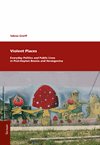Abstract
In this multi-sited ethnography, the author explores how political agency is shaped through interactions on public places across four central Bosnian and Herzegovinian cities. The author shows that everyday life on public places in post-war Bosnia and Herzegovina is fundamentally political: either by design or by default, and that no one can escape the highly dynamic negotiations of rights, duties, and obligations that occur in every public interaction. These positioning games are far from innocent; they create elites, manifest political power, and in the same moment cut out more and more citizens of Bosnia and Herzegovina from the promises set by market economy and democracy. Through examining hundreds of interactions on public spaces ranging from soccer stadiums and market halls to graveyards, this study not only shows how post-war political agency in Bosnia and Herzegovina is bound to the public realm, but also that options for defining one’s personal future are less linked to ethno-national group membership than widely assumed. Instead local, generational, and economic differences play a significant role in determining everyday livelihood. These factors – unique in their composition in every observed place – highlight a new realm of conflict potentials that will shape the future of Bosnia and Herzegovina over the next decade.
Zusammenfassung
In this multi-sited ethnography, the author explores how political agency is shaped through interactions on public places across four central Bosnian and Herzegovinian cities. The author shows that everyday life on public places in post-war Bosnia and Herzegovina is fundamentally political: either by design or by default, and that no one can escape the highly dynamic negotiations of rights, duties, and obligations that occur in every public interaction. These positioning games are far from innocent; they create elites, manifest political power, and in the same moment cut out more and more citizens of Bosnia and Herzegovina from the promises set by market economy and democracy. Through examining hundreds of interactions on public spaces ranging from soccer stadiums and market halls to graveyards, this study not only shows how post-war political agency in Bosnia and Herzegovina is bound to the public realm, but also that options for defining one’s personal future are less linked to ethno-national group membership than widely assumed. Instead local, generational, and economic differences play a significant role in determining everyday livelihood. These factors – unique in their composition in every observed place – highlight a new realm of conflict potentials that will shape the future of Bosnia and Herzegovina over the next decade.
- 1–16 1 Introduction 1–16
- 111–154 5 Mostar 111–154
- 155–196 6 Sarajevo 155–196
- 197–248 7 Goražde 197–248
- 249–302 8 Banja Luka 249–302
- 303–320 9 Conclusion 303–320
- 321–360 Appendix 321–360

